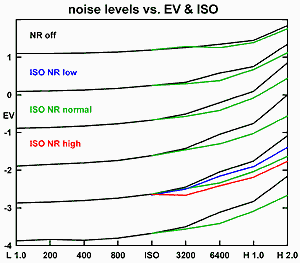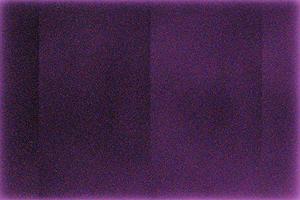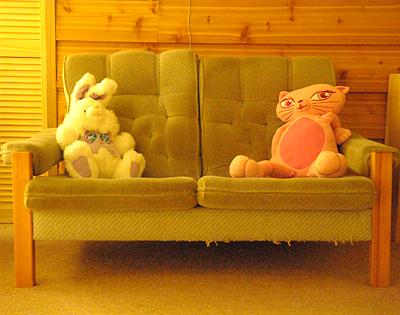To deal with noise, Nikon provides two processing mechanisms in the D3/700, one based on the statistics of the image (high ISO NR), the other based on dark frame subtraction (long exposure NR). The first relies on statistical techniques since shot noise is gaussian random - it's only applied at ISO 2000 and above. Thermal, conductive and pixel noise are what the long-exposure noise reduction specifically reduces - it's done by taking a second dark exposure right after the photo, then effectively subtracting the two, and is only applied with exposure times greater than 1 second.
The first graph shows the noise levels in stops for sRBG TIFF images taken of a neutral grey test card at ISO 6400 with the maximum resolution of the camera, 4256x2832 pixels. The tick interval is 1/6 stop, the sRBG gamma range of the camera is 6.3 stops, so a noise level of one division is 2.6% (RMS) of the maximum bright-to-dark signal. ISO 6400 is chosen to maximise the noise effects; at sensitivities greater than that, high ISO NR can't be turned off on the D3/700. Normal noise reduction in the D3/700 allows a doubling of ISO for similar noise levels, high reduction roughly 4x the ISO.
The second graph shows long exposure dark noise, again at ISO 6400 to maximise visibility. It increases at room temperature (20C) at exposure times longer than a minute. The maximum useful duration at this ISO and temperature is 8 minutes. A 16 minute dark exposure with no noise reduction is shown below it; conductive noise to the backplane predominates there. The green curve shows the effects of the long-exposure noise reduction in the camera - it roughly doubles the usable exposure duration. As shown by the red curve, cooling the sensor to 5C allows exposures ten times as long as at 20C without noise reduction. Cool temperatures are far more effective than the in-camera noise reduction.
The non-linear effects of long exposure times are due to diffusion of carriers across the sensor from the backplane that collects the signals. In this region, splitting the exposure up into shorter sections can produce superior results. The noise level of a single 30 minute exposure at 20C is 2.9 stops, that of 8 separate 4 minute exposures added together in Photoshop, 0.35 stops. The camera has a multiple exposure mode; using it to combine eight 4 minute exposures results in a noise level of 0.47 stops, almost the same as recording each of the 8 separately. So, in multiple exposure mode, the camera clearly initialises the sensor before each new exposure, then adds each result in to the final image. Exposure times of more than 8 minutes benefit from this approach. The camera only supports up to 10 exposures in multiple mode, and the mode has to be specifically turned on with multiple button pushes for each sequence, which of course will move the camera, so the Photoshop method is more practical. An external timer is needed to automate it; the camera has an interval timer mode, but only supports individual exposures up to 30 s.
How serious is noise to photographers?
Here are a series of images to illustrate the various levels of noise. The original is at ISO 200, as low noise as you get. The 2nd has 1/10 stop shot noise added, equivalent to the D700 at ISO 3200 and no noise reduction. The 3rd has 1/6 stop added: ISO 6400 with no noise reduction, 12800 with, the 4th, 1/3 stop added: ISO 25600, no noise reduction. The 5th is 30 s at ISO 25600 in a dark cellar with the in-camera noise reductions enabled.
Why does the noise below seem so unimportant visually? Our eyes are not cameras. To our eyes, noise makes a photo seem sharper.
So, you decide how much you have to worry about it. With a D3/700, not much.







